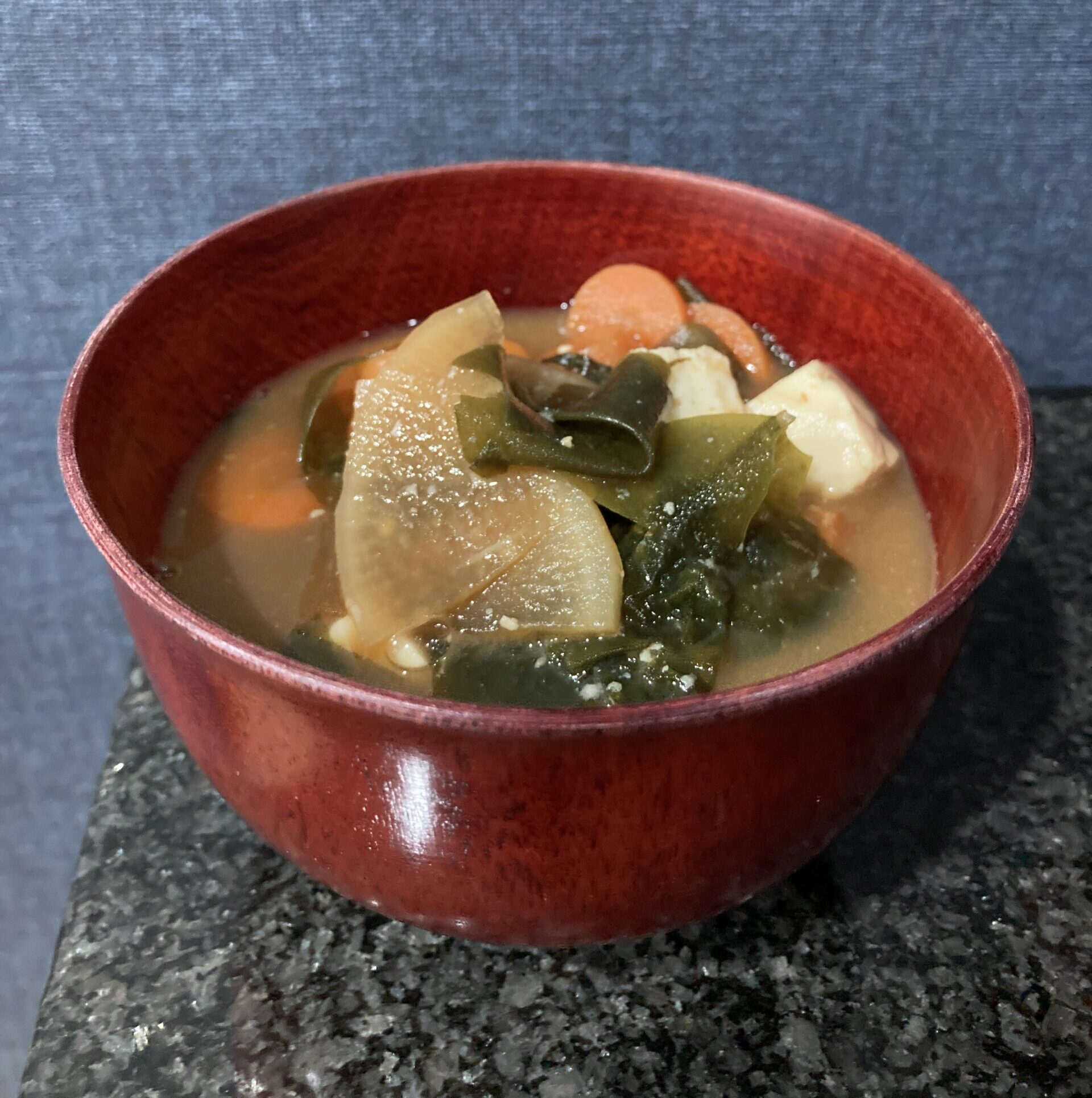Let’s be honest—miso soup seems like it should be obvious.
And yet… when you stand in your kitchen with miso paste, tofu, and seaweed in front of you, the questions begin.
“When do I add the miso?”
“Can I just toss everything into the pot?”
“How much miso should I add?”
No worries. You’ve come to the right place.
This guide explains how to make miso soup in the most basic, comforting, slightly ridiculous way possible—while still being totally legit.
What’s Miso Soup Made Of?
At its heart, miso soup is built on three parts:
- Dashi – the Japanese soup stock (don’t be scared)
- Miso paste – fermented soybean paste (the soul of the dish)
- Ingredients – literally whatever you want (seriously)
Miso soup isn’t picky. It’s that chill friend who says,
“Yeah, throw in whatever—you’re doing great.”
What You’ll Need (for 4 servings):
- 3~4 cups (600~800 ml) water
- 2 tsp instant dashi powder, or a dashi packet, or homemade dashi
- 1~2 Tbsp miso paste
- Any ingredients you like: tofu, wakame, green onions, mushrooms, carrots, daikon…
I usually make 4 servings and keep extra in my fridge. I’m always relieved to see miso soup waiting for me in the fridge when I don’t feel like cooking.
This is just a guide, you can add more dashi powder or miso depending on your preference.
Step 1: Water Matters (Yes, Really)
If you’re using tap water, great. But here’s a fun fact:
Softer water helps extract umami better when making dashi from scratch.
Japan’s natural water tends to be soft, which is perfect for drawing out the flavor of kombu or bonito flakes. If you’re making your own dashi someday, using filtered or bottled soft water can really level it up.
But don’t worry—for now, any water is fine. We’re keeping things chill.
Step 2: Make the Dashi (or Just Add Powder—No Shame)
- Bring 3~4 cups of water to a gentle simmer.
- Add 2 teaspoon of granulated dashi powder.
💡 Lazy but smart tip:
If you’re adding vegetables like daikon or mushrooms, just toss the dashi powder in with them. It’s fine. Miso soup is flexible. It’s not judging you.
If you’re using a dashi packet, follow the package instructions (usually simmer for 5–10 minutes, then remove the packet).
We’ll talk about real, hand-crafted dashi in another post. For now: You’re doing amazing.
Step 3: Add the Ingredients
Throw in whatever you’ve got. Today, I added…
- Cubed tofu
- Dried wakame (it expands like magic!)
- Daikon radish
- Carrots
Tip: Add firmer veggies earlier so they have time to soften. Softer ingredients like tofu go in near the end. Boil your ingredients until cooked.
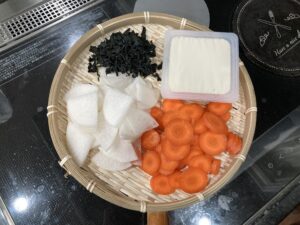
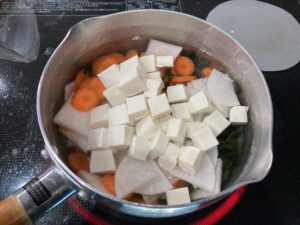
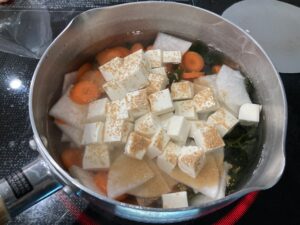
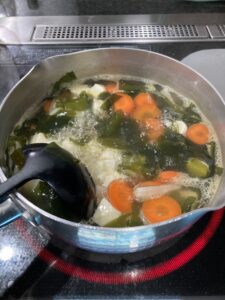
Step 4: Turn Off the Heat Before Adding Miso
Repeat after me:
Don’t boil the miso.
Why?
- It ruins the delicate flavors
- It kills the good bacteria (yes, miso is alive!)
- It’s just… not the way
So here’s the technique:
- Scoop out about 1~2 tablespoons of miso.
- Place it in a ladle in the pot.
- Stir it gently with chopsticks or a spoon until it dissolves. Small whisk is handy too.
- Stir the whole miso soup with your ladle.
Done. You just added miso like a seasoned pro.
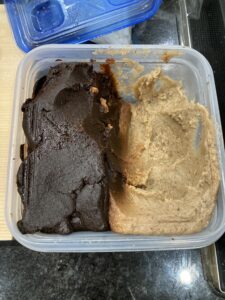
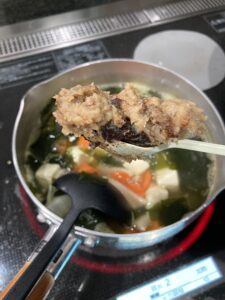
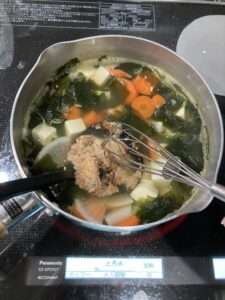
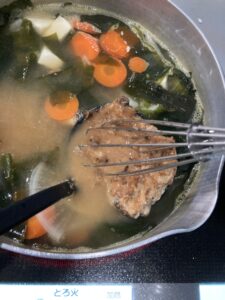
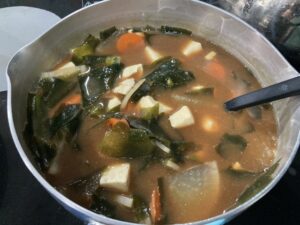
I like my miso soup full of ingredients, so it might be overly crowded for some. Again, it’s up to you to decide!
A Word About Dashi (Because It Deserves Its Own Article)
If you want to explore deeper, dashi is where it gets interesting: kombu (kelp), katsuobushi (bonito flakes), niboshi (dried sardines), dried shiitake—each one brings a different character to your soup.
But that’s a rabbit hole for another day. Stay tuned for a full post about it soon!
Why Miso Soup is Perfect
Miso soup is gentle, warm, and forgiving.
You don’t need to overthink it.
It doesn’t need expensive tools or rare ingredients.
It just wants to comfort you, quietly.
Let’s Call It: “Soup That Loves You Back”
This might be the most basic version of miso soup you’ll ever read. But that’s the beauty of it. Once you’ve made it once, you’ll feel confident to make it again—your way.
Whether you use powdered dashi or artisan kombu, whether it has tofu or random fridge leftovers—it’s all good.
Now go make your miso soup. And let it hug your insides a little.
